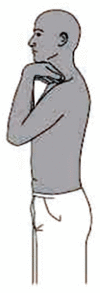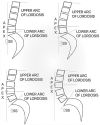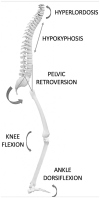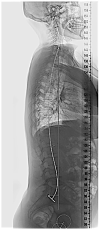Sagittal balance: from theory to clinical practice
- PMID: 35839102
- PMCID: PMC8693232
- DOI: 10.1302/2058-5241.6.210062
Sagittal balance: from theory to clinical practice
Abstract
Adequate sagittal balance (SB) is essential to maintain an upright, efficient, and painless posture. It has been shown that sagittal profile alterations affect quality of life of patients with a similar or even greater impact than chronic disease. Evaluation of the SB has gained much relevance in recent years, with recognition of its importance in the evaluation of spinal pathology. This review summarizes the basic principles of SB, aiming to obtain a practical, simple and understandable evaluation of the sagittal profile of a patient. SB is a dynamic process that involves a varying degree of energy expenditure. Distinguishing between a balanced, compensated imbalance or decompensated imbalanced patient, is relevant to diagnosis and therapeutic decision-making.
© 2021 The author(s) 2021.
Conflict of interest statement
Figures













Similar articles
-
Impact of Fatigue on Maintenance of Upright Posture: Dynamic Assessment of Sagittal Spinal Deformity Parameters After Walking 10 Minutes.Spine (Phila Pa 1976). 2017 May 15;42(10):733-739. doi: 10.1097/BRS.0000000000001898. Spine (Phila Pa 1976). 2017. PMID: 27617839
-
The Sagittal Balance Does not Influence the 1 Year Clinical Outcome of Patients With Lumbar Spinal Stenosis Without Obvious Instability After Microsurgical Decompression.Spine (Phila Pa 1976). 2015 Jul 1;40(13):1014-21. doi: 10.1097/BRS.0000000000000928. Spine (Phila Pa 1976). 2015. PMID: 25893354
-
Coronal curvature and spinal imbalance in degenerative lumbar scoliosis: disc degeneration is associated.Spine (Phila Pa 1976). 2014 Nov 15;39(24):E1441-7. doi: 10.1097/BRS.0000000000000603. Spine (Phila Pa 1976). 2014. PMID: 25202936
-
Restoration of Sagittal Balance in Spinal Deformity Surgery.J Korean Neurosurg Soc. 2018 Mar;61(2):167-179. doi: 10.3340/jkns.2017.0404.013. Epub 2018 Feb 28. J Korean Neurosurg Soc. 2018. PMID: 29526059 Free PMC article. Review.
-
The importance of sagittal balance in adult scoliosis surgery.Ann Transl Med. 2020 Jan;8(2):35. doi: 10.21037/atm.2019.10.19. Ann Transl Med. 2020. PMID: 32055626 Free PMC article. Review.
Cited by
-
Risk factors associated with prevalent vertebral fractures in Duchenne muscular dystrophy.Osteoporos Int. 2023 Jan;34(1):147-160. doi: 10.1007/s00198-022-06578-6. Epub 2022 Nov 7. Osteoporos Int. 2023. PMID: 36342539
-
Low pelvic incidence with low lordosis and distal apex of lumbar lordosis associated with higher rates of abnormal spinopelvic mobility in patients undergoing THA.Bone Jt Open. 2023 Sep 3;4(9):668-675. doi: 10.1302/2633-1462.49.BJO-2023-0091.R1. Bone Jt Open. 2023. PMID: 37659768 Free PMC article.
-
Balance or Strength? Reconsidering Muscle Metrics in Sagittal Malalignment in Adult Sagittal Deformity Patients.J Clin Med. 2025 May 9;14(10):3293. doi: 10.3390/jcm14103293. J Clin Med. 2025. PMID: 40429289 Free PMC article.
-
Automatic 3D pelvimetry framework in CT images and its validation.Sci Rep. 2024 Sep 13;14(1):21431. doi: 10.1038/s41598-024-72123-6. Sci Rep. 2024. PMID: 39271720 Free PMC article.
-
Atypical Scheuermann's disease with severe kyphosis and negative sagittal balance in the thoracolumbar region: A case report and literature review.Int J Surg Case Rep. 2023 Aug;109:108618. doi: 10.1016/j.ijscr.2023.108618. Epub 2023 Aug 4. Int J Surg Case Rep. 2023. PMID: 37557040 Free PMC article.
References
-
- Dubousset J. Three-dimensional analysis of the scoliotic deformity. In: Weinstein S, ed. The pediatric spine: principles and practice. New York: Raven Press, 1994:479–496.
-
- Cobb J. Outline for the study of scoliosis. American Academy of Orthopaedic Surgeons. Instructional Course Lectures, Vol. 5. 1948;5:261–275
-
- Roussouly P, Gollogly S, Berthonnaud E, Dimnet J. Classification of the normal variation in the sagittal alignment of the human lumbar spine and pelvis in the standing position. Spine 2005;30:346–353. - PubMed
-
- Le Huec JC, Hasegawa K. Normative values for the spine shape parameters using 3D standing analysis from a database of 268 asymptomatic Caucasian and Japanese subjects. Eur Spine J 2016;25:3630–3637. - PubMed
LinkOut - more resources
Full Text Sources

